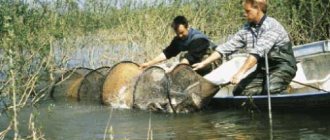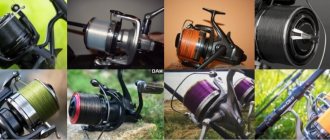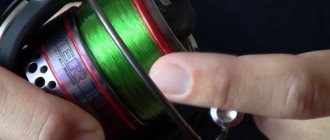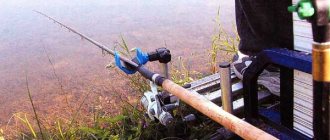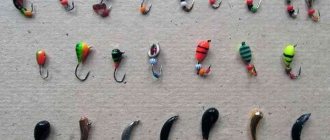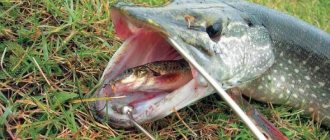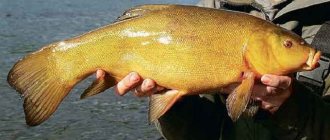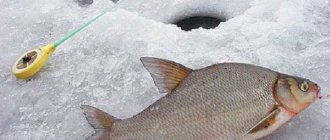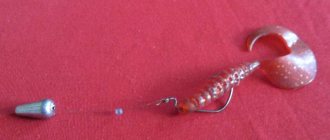Casting nets, capes, parachutes, mantles, capes - many names, but the essence is the same
Yes... it’s not easy to find a more exciting tackle. As soon as you take it in your hands, you immediately imagine wild nature..., crocodiles...! And everything depends only on you, only you and... the fish. Beauty…!
And fish should be treated with special respect - it is far from stupider than a chicken. Can you imagine this - you take a nonsense and chase like a fool across a field after a flock of chickens, geese, etc. Catch up??? That’s how fish are - they see everything, hear everything, and they’ll be even quicker.
But if you hide, for example, around the corner, pour food on the chickens, say three magic words (chick-chick-chick), a well-aimed throw... then the whole flock is yours. They kissed each chicken and sent them away. You can even take a photo.
What's all this for? Besides, I repeat, fish are far from stupid. Your advantage is secrecy, surprise and precision of casting.
Casting nets are intended mainly for catching fish concentrations. (By the way, they are great at scooping out crayfish). The easiest and most effective way to find a concentration of fish is to feed a place, or even better, several. Everyone will be full, both you and the fish!
How to catch is clear - feed and cast quickly and beautifully!
Now - American type or
Spanish type?
American style
the pocket is created by fishing line slings.
After getting out of the water, the line and tackle are leveled, and the entire catch is quickly destroyed along with debris, etc. In the Spanish type,
the pockets are made initially, (structurally) and after pulling the gear ashore, you need to pick out the fish and debris by hand - it’s not at all convenient, and it gets on your nerves!
In short, definitely, American women!
Now what material is it - polyamide thread (ordinary nylon thread - like on nonsense) or monofilament (ordinary fishing line, like on all fishing rods). What to choose?
Polyamide thread is stronger, more durable and the network made from it is more repairable.
A fishing line casting net will be easier to work with (doesn’t get wet), and a little more catchy - it’s thinner, has less windage, so it sinks faster. Briefly and, I think, clear!
Let's not talk about sunken anchors. You can only dive there.
But there is no need to be particularly afraid of stones and snags.
When hooking, you need to reach with your hand (you can use a hook or a branch) to the small upper white sleeve and pull it - the fishing line lines will stretch out, there will be no pocket and the tackle will be freed.
Of course, you will lose your catch, but the tackle is intact. If this does not help, it means that the tackle is caught in the line sling, it’s also not a problem. Don’t pull or tear, but pull the rope and wait until the knot of the tensioned sling slowly but surely comes undone (it’s designed that way) and the tackle is freed. At the same time, you can walk left and right while holding the cord taut. Then, on the shore, turn the tackle over with the lines facing up, find the place where the line was untied and tie it again.
Casting net with a small ring - new for the 2015 season
A cast net with a ring greatly simplifies the casting technique, while the tackle falls into the water in the right circle. You only need to set the initial rotation when casting.
To do this, you need to lift the net above the ground with your arm extended upward and to the side at 45 degrees, stand towards the water with an angle of at least 270 degrees and, turning around, throw the tackle into the water.
A fisherman (woman, child) 1m 45cm tall will be able to cast a tackle with a radius of up to 1.5m.
A fisherman over 1m 70cm tall can cast a radius of 1.8m.
Casting net with large ring - the pinnacle of casting tackle perfection
In order to freely fish with casting gear with a radius of 2m or more, a height of more than 1m 80cm is required.
The large ring works on a completely different principle than the small one and allows you to cast a casting net with a radius of 2.7 m - even while sitting in a rubber boat, which gives the fisherman a completely new field of activity. The advantages are undeniable. The height of the fisherman here no longer matters, and casting is as easy as shelling pears!
Sitting, standing, lying down and kneeling!
Everything written is an easy introduction to this indescribable excitement of fishing with a casting net. Ask questions and we will try to answer everything.
The operating principle of a casting net, which is also called a cape, mantle or parachute, is simple. Such fishing gear is wound around the hand and then thrown to the selected point. Then the net is evenly lowered to the bottom, and then rises to the surface. All fish that were in the coverage area of the cape at the time of casting become prey for the angler.
If you observe an experienced fisherman, it seems that there is nothing difficult in casting such a fishing gear. In fact, it can take weeks and months to master the casting network. It is not for nothing that the Japanese treat the casting technique as an art and organize special competitions for masters of this craft.
At the same time, there is nothing overly complicated in handling such a net, and if desired, anyone can learn to fish with this tool in a very short time. There are two types of casting networks
- Spanish and American. They differ both in design and casting technique.
American type networks with ring
American networks are equipped with rings of various diameters. Unlike Spanish women, the main cord in such models is attached not to the central part of the mesh, but to the strands, so the technique of working with them is significantly different. Their advantage is ease of casting
- the fisherman just needs to take and throw the net at the desired point. Also, American-type models provide more impressive catches than Spanish ones.
When the net is pulled out, the load is pulled to its center, while the entire structure is assembled into a single whole - into a kind of seine with a closed exit.
With a big ring
American nets with a large ring with a diameter of half a meter (Frisbee) can be easily thrown from a boat by throwing it away from you, while the parachute fully opens and completely sinks to the bottom. Models of this type are equipped with three rows of rings
.
To cast such a net, you must:
- spread it out on the ground;
- release the middle ring, after which the large ring falls to the lower cord, and the third ring presses the net;
- put a cuff on your wrist;
- unwind the cord and send the net into the water in a motion similar to launching a frisbee.
No special skill or body rotation is required at the moment of the throw. American Big Ring Net is guaranteed to open in the air
, while tangling of the lines during the casting process is excluded.
After each cast, the net must be cleared of branches and grass; this rule should not be forgotten even in the heat of excitement of fishing. Such careful attention to the fishing process will minimize the likelihood of unpleasant incidents when the net does not unfold as it should, and the throw is unsuccessful, and all potential prey is scared away in vain.
With small ring
The American casting network with a small ring resembles a Spanish woman. It is well suited for fishing in strong wind conditions, including at sea, when gusts make it difficult to throw a Frisbee net. A small ring presses the bag against the cord while pulling.
It must be borne in mind that the possibility of fishing with a net with a small ring of one diameter or another depends on the height of the fisherman:
- with a height of 1 m 45 cm, you can cast a net with a diameter of up to 3 m;
- height 1 m 70 cm allows you to throw nets with a diameter of 3.5 m;
- with a height of 1 m 80 cm and above, you can fish with four-meter nets.
This is how nets of this type differ from American ones, when fishing with which the diameter of the net used does not depend on height.
American
This is a casting network with a ring. It consists of many pieces of triangular woven fabric. They are stitched together in such a way that the resulting mesh has the shape of a dome. The bottom of the circle is covered with a special loaded cord, from which slings diverge along the entire border of the product. These are special ropes that are part of a fishing net. And they are always located on the inside of the gear. At the same time, they pass from the bottom of the network to its top. At the top of the system, the slings are sewn into a kind of ring, around which the bags are assembled.
Spanish casting technique
Nets of this type are more difficult to cast, but their important advantage is that they are less likely to get snagged.
in areas with complex bottom topography.
When pulling a Spanish-type net, the loads converge towards the center of the circle due to their own gravity. To throw it, you need to:
- collect the main (traction) cord in your left hand with rings, check if there are any loops on it;
- take the net by the central part, shake it, stretching and straightening it;
- grab the top of the net with your right hand - about a third of its length - and collect it in one or two loops in your left hand;
- take the weight cord with your right and left hands at two points, spread your arms wide, stretching the net as much as possible;
- turn the body 180 degrees, and then straighten it, simultaneously throwing the net in an arc into the water.
To prevent the entire traction cord from flying into the water after being thrown, the loop at its end must either be secured to the left hand or attached to the belt. The second option is more reliable and completely eliminates the risk of losing gear.
Before going out onto the pond with a net, it is better to practice on dry land.
, choosing an area free from thickets of grass and bushes. At the same time, you can master the technique of folding the net before casting, as well as the casting itself.
Casting net fishing tactics
To always have a good catch, it is not enough to master the casting technique. The nuances of fishing with a casting net are no less than with a float rod or donka. For such fishing, areas of reservoirs with an open bottom, free of vegetation and snags, are suitable. It is inconvenient to use a casting net at great depths and fast currents, and it is better to avoid such points.
Achieving a good catch with this gear is not easy - only a person far from fishing would think that it is enough to throw it into a river or lake to get a good trophy, or even several. In reality, the chances of there being good fish in the netted area are slim.
to catch the fry quickly and without much difficulty
for use as live bait. A net with a small mesh, cast in places where small fish accumulate, will bring good catches with each throw.
To get a more substantial trophy, you need to comb with a cape the points where large fish can be held. Since fishing with a casting net among snags is impossible, it is necessary to check areas with uneven bottoms - holes and edges.
Fishing with bait
Good results when fishing with a cape can be achieved using bait
. You can select several suitable areas on the reservoir and throw food into them for the fish, and then periodically check them with a net, each time adding a fresh portion of food. This tactic increases the chances of success significantly, because it eliminates the need to throw the net blindly at a point chosen at random.
But there is one difficulty - a very accurate throw is necessary, because a net with a diameter of several meters must accurately cover the baited area. To ensure that the bait hits the target exactly, you can mark the feeding points with small buoys
, which will be guidelines when casting. Without them, the chances of putting the tackle on a small feeding table are slim.
For beginners, the rules for handling the casting network often seem complicated, but, as in any business, skill is gained with practice. Many people disdain fishing with a net, but fishing with a cape can hardly be called unsportsmanlike. It involves an active search for fish and requires a lot of physical activity, and achieving a good catch is not easy, but always possible.
Casting network
- First experience. How to choose so as not to be disappointed with fishing?
How often do we hear and see how the so-called casting networks
they soar up and, opening in the air, fall with lightning speed into the water, then picking up everything they managed to catch within the radius of the parachute net.
It’s not for nothing that it’s called a net— a snag
or a parachute net. But the ease with which the casting net is cast in Asia will not be so easy to achieve for a newcomer who decides to try himself in the role of a Texas cowboy, briskly waving a cord, as if taming a wild mustang. Let's figure out what you need to know about the casting network and how to choose it correctly.
Casting networks (parachute) are divided into Spanish and American
. The Spanish type parachute mesh is a mesh that looks like a bag. It is equipped with weights along the lower edge (along the circumference of the fishing tackle), and on top - a cord with a carabiner and a cuff for easy casting. A fishing net bag has sides, small protruding double edges that rise with the net when it is removed from the water to ensure the safety of the catch. For a beginner, working with a Spanish casting net will be much easier and more convenient, because the Spanish net flies through the air on its own, it does not need to ensure full expansion by tugging at the slings, that is, holding lines, as in the American type of casting net. Working with a Spanish bait is easier and more enjoyable; you can get real pleasure from fishing, especially when casting a parachute net far from the shore. Lead weights quickly sink the net to the bottom, and all you have to do is pull the fishing tackle by the rope, which is attached to your hand with a cuff. The Spanish flu throw is best done “from yourself and up”, so it is better to practice this movement with your hand in advance.
American type casting network
It is better to choose one with a small clamping ring. By choosing this net, you will actually buy a Spanish net, but it will have slings that will allow you to tighten the bag of netting into even pockets and lift it without losing your catch. In contrast to the Spanish-type casting net, which often turns over and loses particularly large and heavy catches when the net is skewed and the center of gravity is transferred to the edges of the sides when lifted.
An American-type casting net is always equipped with thick lines-slings that penetrate the diameter of the net and freely collect the net from the weights to the cord into small uniform bags, which are tightened simultaneously when lifting the tackle with the catch. The disadvantage of such a mesh is the inevitable process of tangling the lines with each other or with the lead weights of the lower section of the net. If you can avoid the latter - a huge number of models of capes are now sold with sewn-in lead weights to reduce snags, then it is impossible to avoid twisting the mesh with slings, unless you have experience.
Casting Network American
is a more effective fishing tackle - its catch is always higher and better, but it is more difficult to cast. Recently, casting American women with a small ring and with weights closed in the cord were invented. Perhaps, today this is the most acceptable mesh for a beginner; it ensures that the entire circumference of the mesh is closed into bags with slings, and is easily tightened with slings to the pressure ring.
Parachute nets with traditional metal lightweight rings with a diameter of 30 and 40 cm, which are used by the residents of Southeast Asia themselves, are easier to open; they guarantee full opening of the net in the air and uniform simultaneous immersion of the gear over the entire area covered by the net. But to start working with a ring mesh, you need to learn how to unwind it. You need to unwind the American casting net on your own, having first moved it onto slings and distributed it evenly on the ground. Next, the net is picked up in the hand and spun like a throwing disc, throwing it as far and evenly into the water as possible. But everything is not as sad as it seems, because we want to enjoy the process of fishing with a net and we will do it!
American style casting nets with a large Frisbee ring have recently gone on sale. This is a plastic ring that has the shape of a circle with parallel arched stripes that converge to the center of the bottom ring of the Frisbee. These arches allow you to pick up and capture air currents in the process of casting fishing gear, as if you were throwing a regular flying saucer to a dog. It’s not for nothing that these networks quickly acquired the name “ Flying Saucer.”
". These models have 3 rings: a large one for casting and directing the air flow during flight, a middle one for lines and their collection, and the last - the smallest - is a pressure ring, with which you press the pre-stretched net with lines to the bottom ring of the frisbee and when With the help of a throw-in cord with a cuff, put on your hand, you throw the net away from you into the water without untwisting the body, as in all other models of American casting nets. Thus, the Flying Saucer casting net is convenient equipment for beginners. It is easy to cast, has slings and a large diameter ring of 50 cm, thanks to which the net does not fold and opens entirely when thrown. And also no skill or training is required to use it. The Flying Saucer casting net is convenient to cast from a boat, from the shore, or from a pier.
Don't think that a larger mesh diameter will give you more fun and a bigger catch. No, on the contrary, nets with a larger diameter, that is, an opening greater than 3 meters, are harder to throw, and they have a higher percentage of non-opening of the full parachute of the net. If the net parachute does not open, there will be no catch.
The question is often asked: what is the best network to choose from? From fishing line or from nylon?
Made from fishing line - casting net is lighter, easier to cast and does not require drying after use. But the mesh made of fishing line is less durable, especially at the knots, and breaks faster.
A net made of nylon is more durable, can withstand a larger catch, and is recommended even for sea fishing with sea water, but when wet it becomes heavier and you won’t be throwing it back for a long time. After use, the network must be dried.
The choice is yours, the main thing is the pleasure of fishing, which you will undoubtedly experience when using a casting net. We wish you success!
Casting nets, casting nets, parachutes, casting nets, capes
- many names, but the essence is the same
Yes, it’s not easy to find a more exciting tackle than a casting net. As soon as you pick it up, you immediately imagine wild nature, where everything depends only on you!
What's all this for? Moreover, your advantage is stealth, surprise and precision of casting.
Casting nets are designed mainly for catching accumulations of fish (by the way, they are also excellent at scooping out crayfish). The easiest and most effective way to find a concentration of fish is to feed a place, or even better, several. Everyone will be full, both you and the fish! How to catch is clear - feed and throw! Fast and beautiful!
American or
Spanish type?
American style
the pocket is created by fishing line slings.
After getting out of the water, the line and tackle are aligned, the entire catch is quickly shaken out along with the debris, etc. In the Spanish type,
the pockets are made from the very beginning (structurally) and after pulling the gear ashore you need to remove both the fish and the garbage manually - this is not convenient, and it gets on your nerves!
In short, definitely, American women!
Now about the material - polyamide thread (ordinary nylon thread - like on nonsense) or monofilament (ordinary fishing line, like on all fishing rods). What to choose?
- Polyamide thread is stronger, more durable and the network made from it is more repairable.
- A fishing line casting net will be easier to work with (doesn’t get wet), and a little more catchy - it’s thinner, has less windage, so it sinks faster. Briefly and, I think, understandable.
Let's not talk about sunken anchors. You can only dive there. But there is no need to be particularly afraid of stones and snags. When hooking, you need to reach with your hand (you can use a hook or a branch) to the small upper white sleeve and pull it - the fishing line lines will stretch out, there will be no pocket and the tackle will be freed.
Of course, you will lose your catch, but the tackle is intact. If this doesn’t help, it means that the tackle got caught in the fishing line, that’s not a problem either. Do not tug or tear, but pull the rope and wait until the knot of the tensioned sling slowly but surely comes undone (it is designed that way) and the tackle is released. At the same time, you can walk left and right while holding the cord taut. Then, on the shore, turn the tackle over with the lines facing up, find the place where the line was untied and tie it again.
Casting net with a small ring - new for the 2016 season
A cast net with a ring greatly simplifies the casting technique, while the tackle falls into the water in the right circle. You only need to set the initial rotation when casting. To do this, you need to lift the net above the ground with your arm extended upward and to the side at 45 degrees, stand towards the water with an angle of at least 270 degrees and, turning around, throw the tackle into the water. A fisherman (woman, child) 1m 45cm tall will be able to cast a tackle with a radius of up to 1.5m. A fisherman over 1m 70cm tall can throw tackle with a radius of 1.8m.
Casting net with large ring - the pinnacle of casting tackle perfection
In order to freely fish with casting gear with a radius of 2m or more, a height of more than 1m 80cm is required. The large ring works on a completely different principle than the small one and allows you to cast a casting net with a radius of 2.7 m even while sitting in a rubber boat, which gives the fisherman a completely new field of activity. The benefits are undeniable. The height of the fisherman here no longer matters, and casting is as easy as shelling pears!
Sitting, standing, lying down and kneeling! Everything written is an easy introduction to the gambling world of casting net fishing. Ask questions and we will try to answer everything.
A casting net, or, as it is also called, a cast net, is considered one of the most effective fishing gear. With just one swing, the net is lowered into the water, covering a certain area. In a few minutes you can already be with your catch.
If you look from the outside, the casting process does not present any difficulties, but in fact, in order to cast the tackle correctly, you need to practice a lot. To use a casting net, first of all you need to take an interest in the casting technique, otherwise you will not be able to do it correctly. To master the technique perfectly, you need to use the gear regularly. Moreover, this rule applies to the use of any tackle, even an ordinary float fishing rod.
The casting net is made of net fabric in the form of a circle. A strong cord with weights is attached to the edges of this canvas. So that the net can straighten out during the flight, a strong braided cord with a diameter of about 5 mm is attached to its middle. To make throwing more convenient, use tackle of optimal sizes. As a rule, people start working on large networks when they already have serious experience.
In the place where you intend to fish, the depth of the reservoir must be known, since the length of the cord is limited. In addition, it is necessary to calculate how much area can be fished and what kind of fish you plan to catch. Based on these calculations, a network with the required cell sizes is manufactured.
The casting net shows good results when fishing for carp, especially in the dark. During this period, carp move to the shallows in search of food. It is advisable to take a flashlight with you so as not to fish blindly. The flashlight must be powerful enough to pierce the water with its beam. You will need it to locate the fish. Plus, light always attracts fish. In fact, there is nothing complicated in the fishing process. To do this, you need to collect the entire net in your hand and throw it in a certain way. The net opens up in flight and covers a certain area of the water area where the prey is located. When it has already sank to the bottom, the fisherman pulls the cord towards himself, which causes the net to shrink. Thus, the prey falls into the trap. When throwing a casting net, it is necessary to accurately calculate the direction and force of the throw, otherwise the net will not have time to open in time.
Not everywhere, not in all regions, fishing with a casting net is considered poaching. In some regions, fishing with this gear is allowed if the diameter of the net is no more than 2 meters. Therefore, before starting to use a casting net, it is necessary to check with the fisheries authorities whether such gear can be used and, if so, under what conditions. It is possible that you will have to pay for a license at the fisheries inspection and please use it to your heart’s content. Catching fish with a casting net is quite a gambling activity that can be more classified as a hobby or sport fishing. Unfortunately, you have to pay for such pleasure. This net can be used for fishing in paid ponds, provided that the caught fish is released back into the reservoir. Only, it’s hard to imagine a fisherman with a casting net on a paid reservoir. The fact is that few of the owners of paid ponds imagine the process of such fishing.
How to cast a casting net correctly
Before you go fishing, it is better to practice how to properly cast the tackle at home, in the yard or on the asphalt in front of a high-rise building. When the net is cast, it must be cleared of mud, algae, old leaves or small branches, otherwise they will interfere with the correct casting of the gear. So, in order to cast a casting net correctly, you must sequentially perform the following steps:
- The main cord must be gathered into rings in one hand, preferably in the left, however it is more convenient for you. With the other hand, the net is lifted and shaken so that it unfurls.
- In this case, you need to make sure that there are no loops and that the tackle itself is not twisted.
- After it is discovered that there are no loops, the net is assembled into rings in the same hand where the cord is located. The weight cord unfolds to the maximum and is grasped at two points.
- The net is ready to be thrown. It is thrown with one movement of the left hand or swung from side to side and only then is it thrown.
- When throwing, the body must be rotated 180 degrees. This will increase the power of the throw.
- The net must be directed along such a trajectory that it can open without reaching the surface of the water.
- The stronger the throw, the more likely it is that the net will open on time. If this does not happen, then this is evidence that too little training was done.
- Before throwing, the loop can be attached to your belt so that the net does not slip out of your hand. This happens because your hands are wet and therefore slippery.
Every angler who has such gear is fluent in the technique of casting a casting net. The details of the technique may not differ significantly, but the whole principle of using such equipment is almost the same.
First way
This method is suitable when the diameter of the gear does not exceed 2 meters. At the same time, it can be thrown without collecting the top into loops.
Throwing process:
- Hands should be free and relaxed. First of all, you need to pick up the weight cord.
- Whatever doesn’t fit in your hand is gathered into loops, several loops in each hand.
- The mesh is wound until its bottom is 40 cm above the ground.
- After this, the net can be cast in one but precise movement. The throwing technique is approximately the same as the technique of throwing a sheet on a bed.
- The technique, although simple, requires training, since it requires a certain accuracy and throwing range.
As mentioned above, each angler develops his own casting technique. The second method does not require the traction cord to be gathered into rings and wound around the hand. You don't have to touch the cord at all, leaving it on the ground. The main thing is that when casting it unwinds correctly. If he gets caught on something, the throw will not work.
This method is quite practical because it saves a lot of precious time. You can make 30 percent more throws, which means you can fish a much larger area of the reservoir, catching more fish.
Casting net with ring - casting technique
Such networks are called American and are considered more efficient than other types of networks. The highlight of this tackle is its special design, which allows for more accurate and reliable casts, guaranteeing success.
The process of throwing tackle with a ring:
- The pulling cord is gathered in rings in the left hand, after which the net is shaken so that it straightens out.
- The process must be monitored for loops formed both on the network and on the cord.
- Using the right hand, the net is intercepted at the top at a distance of 1/3 of its length, after which it is collected in skeins in the left hand.
- After this, the cargo cord is grabbed at the extreme points, and the net itself should be deployed as widely as possible.
- When throwing, you should assist the cast with a body movement that should turn 180 degrees.
- Just before the throw, the net can be swung, which will increase the throw range.
- The tackle is directed along a flat horizontal trajectory. As a result of this specificity of the flight, the network deploys almost right next to the water.
- The greater the force of the throw, the more reliable the operation of the tackle. Only a straightened net after entering the water can guarantee a catch.
DIY casting network photo
Note!
How to minimize fishing costs? Useful tips from experienced fishermen and an overview of current solutions (65 photos)Do-it-yourself boat motor - tips for beginners, projects, drawings and step-by-step description of the construction of the main components and elements (video + 120 photos)
Feeder for winter fishing - secrets of use and techniques for feeding fish in winter (115 photos)
Help the project, share on social networks
0
Spanish casting net: casting technique
The Spanish network has some differences related to the attachment of the pull cord. This cord is attached to the center of the tackle, but not to the cores, as in other types of nets. The Spanish casting net uses a thicker weight cord, which does not cut into your hands as much when pulling the net out of the water. The length of the cord can reach 5 meters.
In appearance, the net is no different from a regular casting net or from an American one, but in the process of pulling it out, a slightly different technique is used. When the American one is used, the load is pulled to the center of the net, after which the net is closed. In this form, it looks more like a seine, without an exit point.
Using the Spanish flue is somewhat simpler, since the load itself moves to the center of the network under gravity. As a result of this, the fish themselves fall into those places where there are pockets for fishing.
Catching fish with casting nets is an interesting, exciting and gambling spectacle, more reminiscent of some kind of sport where athletes compete for casting distance and accuracy. Despite this, this type of fishing can bring a significant catch if you learn how to cast this gear correctly. Unfortunately, this does not mean that if the casting technique is mastered, then the catch is guaranteed. If you cast a net and don’t know that there are no fish in this place, then such fishing will take up a lot of precious time solely on useless casts. Modern fishing is characterized by the fact that you need to look for fish, otherwise you may be left without a catch. Nowadays, there are fishermen's assistants, in the form of echo sounders, which can identify promising places. This is the only way to count on success.
What does a casting structure look like?
Making a casting net with your own hands involves a preliminary study of the design. The American type model is in most cases considered the most common.
This type of fishing gear contains the following parts:
The woven base itself is made from a special monofilament material. During production, the fabric is treated with a special substance so that the resulting network is soft and pliable. For correct and comfortable opening, it is pre-stretched at the factory.
Read here Sleds for fishing - a step-by-step description of how to choose and make a sled with your own hands (135 photos)
The second component is a cord with weights, which helps, when pulled out of the water, to collect the net and all the prey that falls into it. By tightening the net, the fish are no longer able to escape from the trap.
There is also a carabiner on the net that prevents the gear from twisting.
There is a horn that helps collect the top of the net.
Another component is the casting cord. It is made of polypropylene, which after casting remains on the surface due to the buoyancy properties of the material.


